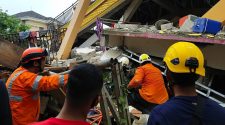Have you noticed that Netflix has been having streaming issues while you’re binge-watching your favorite show? How about connectivity problems during a Zoom call? Or longer-than-usual wait times when loading up a page while online shopping? Have you had trouble downloading big work files? These aren’t one-off problems. And, today, they are often symptoms of a much larger issue — something is going terribly wrong with residential connectivity across the United States.
The coronavirus has sent over a hundred million Americans home — to work, to play, to learn and to shop. Thanks to decades of deferred investment in universal broadband infrastructure, this increased home internet use is killing our connection speeds across the country. Adding insult to injury, these speed degradations appear to be especially acute in rural areas and areas that already have poor broadband service.
Right now, an international consortium of network scientists is collecting 750,000 U.S. broadband speed tests from internet service provider (ISP) customers each day, and we’ve been tracking a stunning loss of connectivity speeds to people’s homes. According to most ISPs, the core network is handling the extra load. But our data show that the last-mile network infrastructure appears to be falling down on the job.
During the last half of February 2020, our research shows that 1,708 counties (52.8 percent) in the U.S. had median download speeds that did not meet the Federal Communication Commission’s minimum criteria to qualify as “broadband” connectivity. By the last two weeks of March 2020 (following widespread shelter-in-place orders across the U.S.), we found that the number of counties that did not meet the FCC’s minimum criteria for broadband speed had increased to 2,012 (62.2 percent).
Don’t forget, these numbers are based on those who had connectivity in the first place. If you added in all the households that have no connectivity, the results would look even bleaker.
We also looked at speed statistics by state. A dozen states saw modest speed increases between February and March. But a whopping 38 states saw slower speeds — and five states (Connecticut, New Hampshire, North Dakota, Wisconsin and Iowa) had median download speeds that were over 20 percent slower than the prior month.
On the whole, the average median download speed degradation across the 50 states and the District of Columbia was -7.6 percent.
To put it bluntly, our internet is breaking. And it’s not breaking equitably.
There’s much more to learn from our speed test results, which is why we’ve made our data publicly available. But what we’ve already found points to disparities in broadband service itself, as well as a plethora of new connectivity problems that Americans are now facing in the pandemic era.
So, what do we do about it? Massive new infrastructure funding containing tens of billions of dollars for broadband buildout is expected to be introduced in Congress in the near future. If we want these funds to be deployed and used well, we need extensive, independent analysis of the true state of broadband connectivity in this country.
Congress and the Federal Communications Commission (FCC) should mandate that ISPs provide service to the areas they claim to serve and at the speeds they claim to provide — that alone would lead to far more accurate and precise information being reported (and would cost taxpayers next to nothing to implement).
Numerous studies, including those conducted by the FCC itself, show that broadband pricing is the second-largest barrier to broadband adoption (availability is the first). It’s obvious that if people are being charged a lot for a service, they’re less likely to purchase it. And independent researchers have already documented that poor areas often pay more than rich communities for connectivity. Redlining of minority and rural areas appears to be widespread, and we need accurate pricing data from the FCC to meaningfully address these disparities.
And consumers should begin to systematically document when they have problems with their ISPs by immediately filing complaints with the FCC and the Federal Trade Commission. Both agency’s complaint forms take only a few minutes to fill out — so why not file while waiting on hold for your internet provider to answer your call?
Finally, we need to start assessing why our policies are creating a group of second-class online citizens. We need to promote any and all solutions that will lessen the broadband divide. We need to change our federal and state broadband funding models to ensure that recipients of tax-payer-supported grants and loans can never implement sub-standard connectivity, and mandate that the services offered are at market rates. And we need an actual National Broadband Plan that includes the major investment funding needed to ensure universal, affordable, broadband connectivity for everyone, everywhere.
The coronavirus pandemic has acted as a harsh lens, magnifying the cracks and flaws in our economy, infrastructure and social safety net. We are living through a catalyzing moment, when internet connectivity is becoming the core pillar of our social lives, our learning and our economy. We must ensure that this critical resource is robust enough to handle everything we require from it. In the immediacy, our challenge is to address two core issues: Accurately documenting the true state of connectivity in the U.S. and funding and executing a plan that will ensure equitable access to this critical resource. We need independent due diligence and documentation of broadband reality, and a far-reaching universal service mandate that will meaningfully ameliorate existing digital divides.
While these national broadband investments are expensive, the opportunity cost of our delay is quickly becoming a far greater expenditure.
Sascha Meinrath is the Palmer Chair in Telecommunications at Penn State University and the co-founder of M-Lab, the largest collection of open internet performance data in the world.

















